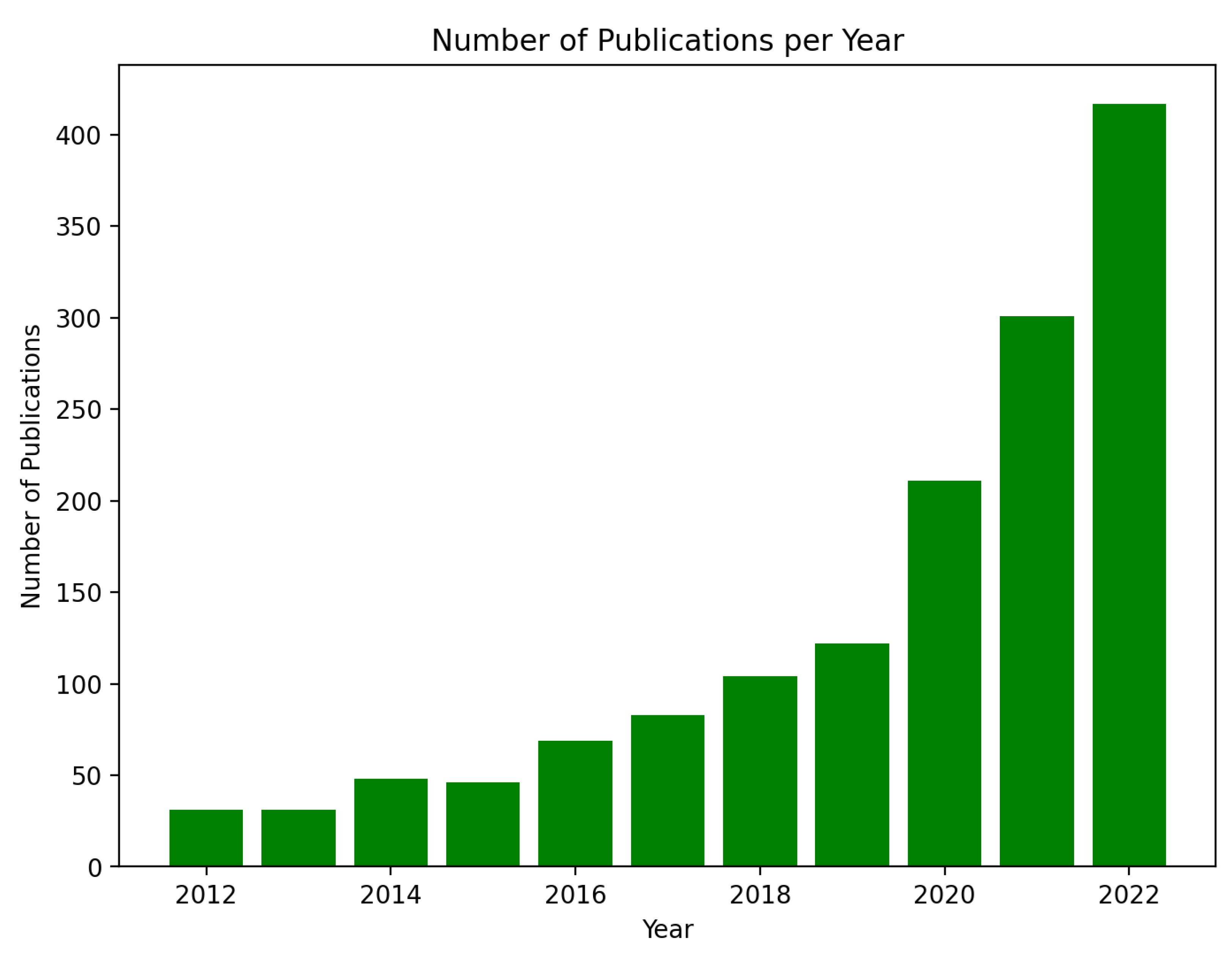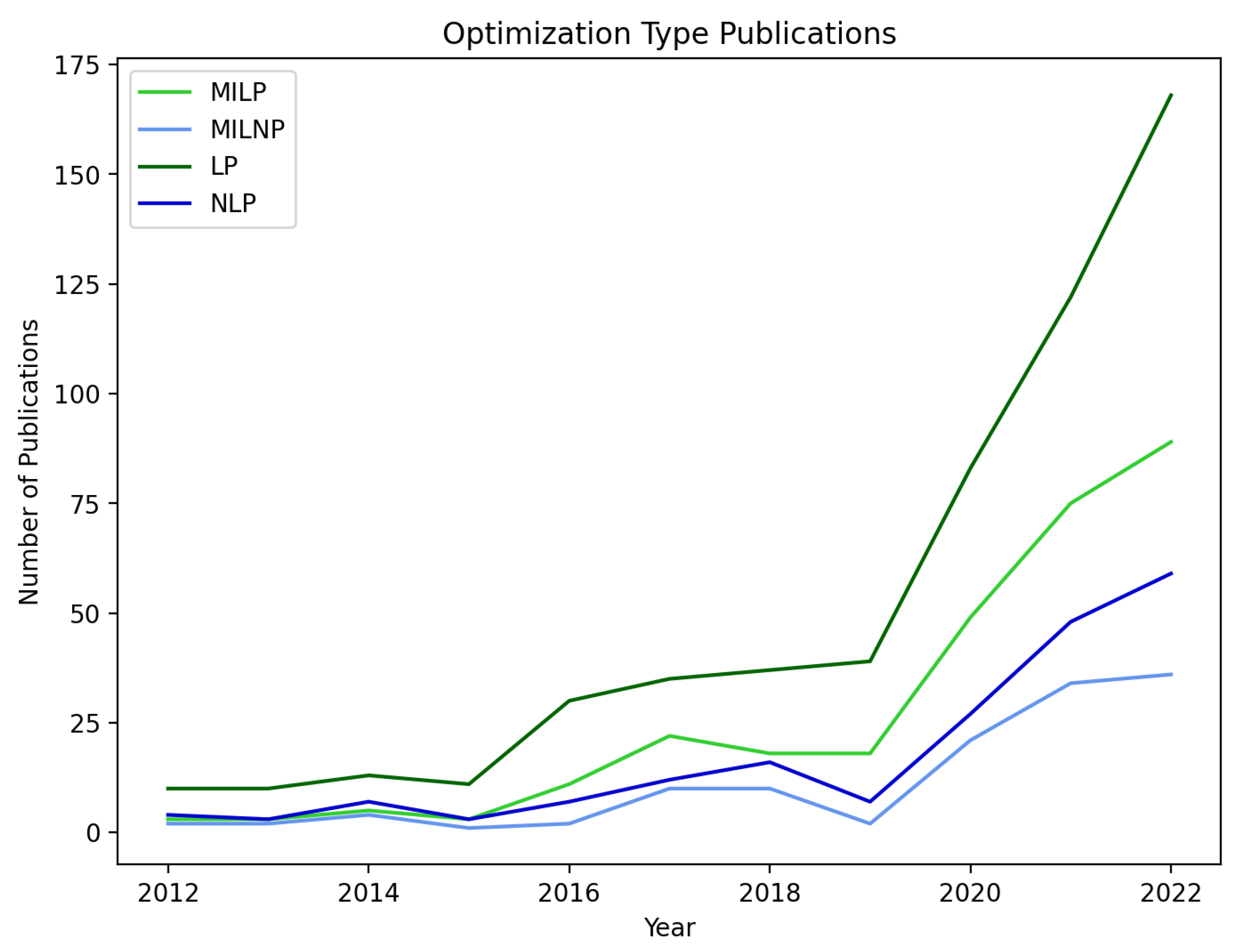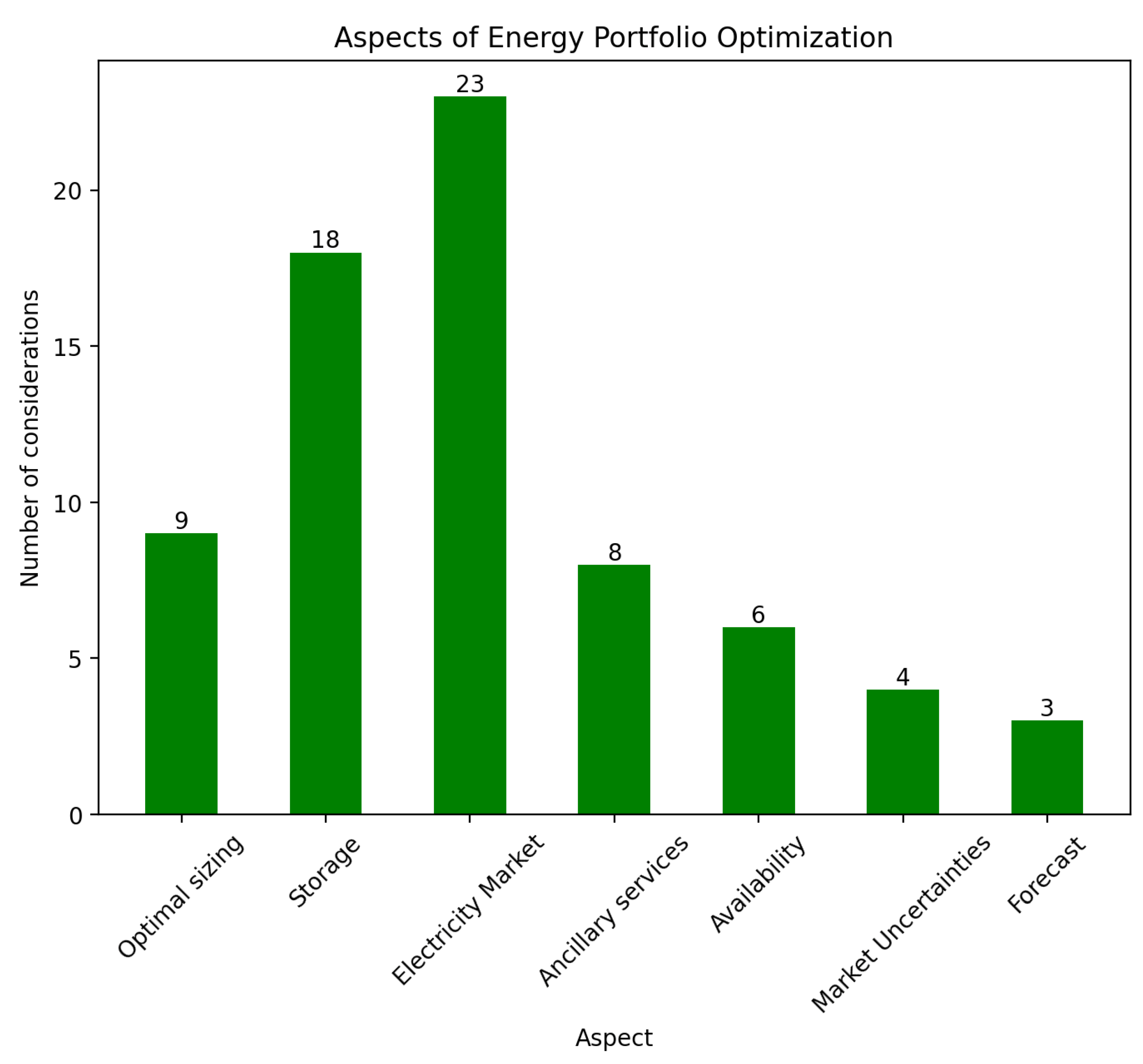Review of Energy Portfolio Optimization in Energy Markets Considering Flexibility of Power-to-X
Abstract
1. Introduction
2. Current and Future Need for Flexibility and Control
3. Parameters Influencing the Efficiency of the Electrolyzer Technologies
3.1. Alkaline Electrolysis Cell

3.2. Proton Exchange Membrane Electrolysis Cell
3.3. Solid Oxide Electrolysis Cell
3.4. General Efficiency Parameters
4. Importance of Optimization for the Flexible Energy Portfolio
4.1. Ancillary Service Participation
4.2. Spot Market Participation and Storage
4.3. Forecast and Market Uncertainties
4.4. Optimal Sizing of Energy Portfolio
5. Trend in Publications
- Electricity market
- Hydrogen
- Electrolyzer
- Optimization
6. Literature Review of State-of-the-Art Optimization Models
Research Challanges
7. Conclusions
Author Contributions
Funding
Institutional Review Board Statement
Data Availability Statement
Conflicts of Interest
Abbreviations
| AC | Alternating current |
| AEC | Alkaline electrolyzer cell |
| AEMEC | Anion exchange membrane electrolyzer cell |
| aFRR | Automatic frequency restoration reserve |
| CVaR | Conditional Value at Risk |
| DC | Direct current |
| DR | Demand response |
| DSM | Demand sidde management |
| EV | Electric Vehicle |
| FCR | Frequency containment reserve |
| HRS | Hydrogen refuelling station |
| IEA | International Energy Agency |
| LCOH | Levelized cost of hydrogen |
| LP | Linear programming |
| MARI | Manually activated reserves initiative |
| mFRR | Manual frequency restoration reserve |
| MG | Microgrid |
| MILNP | Mixed integer non-linear programming |
| MILP | Mixed integer linear programming |
| NLP | Non-linear programming |
| PEMEC | Proton exchange membrane electrolyzer cell |
| PICASSO | Platform for the international coordination of automated frequency restoration and |
| stable system operation | |
| PV | Photovoltaic |
| RE | Renewable energy |
| SOEC | Solid oxide electrolyzer cell |
| TRL | Technology readiness level |
| TSO | Transmission system operator |
References
- Smil, V. Energy Transitions: Global and National Perspectives, 2nd revised ed.; ABC-CLIO, LLC: Santa Barbara, CA, USA, 2017; p. 282. [Google Scholar]
- The Commission to the European Parliament, the European Council, the Council, the European Economic and Social Committee and the Committee of the Regions, Commission Report—REPowerEU Plan, Brussels, 18.5.2022 COM(2022) 230 final. Available online: https://eur-lex.europa.eu/legal-content/EN/TXT/?uri=COM%3A2022%3A230%3AFIN&qid=1653033742483 (accessed on 27 January 2023).
- IEA. Renewables 2021; License: CC BY 4.0; IEA: Paris, France, 2021; Available online: https://www.iea.org/reports/renewables-2021 (accessed on 27 January 2023).
- Energinet. CASE BESKRIVELSER. 2022. Available online: www.energinet.dk/el/systemydelser/introduktion-til-systemydelser/case-beskrivelser/ (accessed on 27 January 2023).
- Fernandez, G.; Jose, O.; Mariya, K.; Joshua, E.; Aaron, T. USDOE Office of Energy Efficiency and Renewable Energy, and California Air Resources Board. RODeO (Revenue Operation and Device Optimization Model).Computer Software. 23 June 2020. Available online: https://www.osti.gov//servlets/purl/1828183 (accessed on 27 January 2023).
- Tuinema, B.W.; Adabi, E.; Ayivor, P.K.; García Suárez, V.; Liu, L.; Perilla, A.; Ahmad, Z.; Rueda Torres, J.L.; van der Meijden, M.A.; Palensky, P. Modelling of large-sized electrolysers for real-time simulation and study of the possibility of frequency support by electrolysers. IET Gener. Transm. Distrib. 2020, 14, 1985–1992. [Google Scholar] [CrossRef]
- Ali, A.; Shakoor, R.; Raheem, A.; Muqeet, H.A.; Awais, Q.; Khan, A.A.; Jamil, M. Latest Energy Storage Trends in Multi-Energy Standalone Electric Vehicle Charging Stations: A Comprehensive Study. Energies 2022, 15, 4727. [Google Scholar] [CrossRef]
- Danish Energy Agency (DEA). Development and Role of Flexibility in the Danish Power System. Solutions for integrating 50% wind and solar, and potential, future solutions for the remaining 50%. 23 June 2021. Available online: https://www.renewable-ei.org/pdfdownload/activities/KristofferB%C3%B6ttzauw_220906_REI-DK_Seminar.pdf (accessed on 27 January 2023).
- Jørgensen, C.; Ropenus, S. Production price of hydrogen from grid connected electrolysis in a power market with high wind penetration. Int. J. Hydrogen Energy 2008, 33, 5335–5344. [Google Scholar] [CrossRef]
- Energinet Systemansvar. SCENARIERAPPORT 2022—2032 Forventninger til fremtidens Systemydelser. 2022. Available online: www.energinet.dk/El/Systemydelser/Systemydelser-i-fremtiden (accessed on 27 January 2023).
- Energinet Systemansvar. Prequalification of Units and Aggregated Portfolios. Available online: https://en.energinet.dk/media/rpaobdcc/prequalification-of-units-and-aggregated-portfolios.pdf (accessed on 27 January 2023).
- Scott, K. Chapter 1 Introduction to Electrolysis, Electrolysers and Hydrogen Production. In Electrochemical Methods for Hydrogen Production: The Royal Society of Chemistry; Royal Society of Chemistry: London, UK, 2020; pp. 1–27. [Google Scholar]
- IEA. Electrolysers; License: CC BY 4.0; IEA: Paris, France, 2022; Available online: www.iea.org/reports/electrolysers (accessed on 27 January 2023).
- Zeng, K.; Zhang, D. Recent progress in alkaline water electrolysis for hydrogen production and applications. Prog. Energy Combust. Sci. 2010, 36, 307–326. [Google Scholar] [CrossRef]
- Schmidt, O.; Gambhir, A.; Staffell, I.; Hawkes, A.; Nelson, J.; Few, S. Future cost and performance of water electrolysis: An expert elicitation study. Int. J. Hydrogen Energy 2017, 42, 30470–30492. [Google Scholar] [CrossRef]
- Rahim, A.H.A.; Tijani, A.S.; Kamarudin, S.K.; Hanapi, S. An overview of polymer electrolyte membrane electrolyzer for hydrogen production: Modeling and mass transport. J. Power Sources 2016, 309, 56–65. [Google Scholar] [CrossRef]
- Palys, M.J.; Daoutidis, P. Power-to-X: A review and perspective. Comput. Chem. Eng. 2022, 165, 107948. [Google Scholar] [CrossRef]
- Hauch, A.; Kungas, R.; Blennow, P.; Hansen, A.B.; Hansen, J.B.; Mathiesen, B.V.; Mogensen, M.B. Recent advances in solid oxide cell technology for electrolysis. Science 2020, 370, eaba6118. [Google Scholar] [CrossRef]
- Cossar, E.; Murphy, F.; Baranova, E.A. Nickel-based anodes in anion exchange membrane water electrolysis: A review. J. Chem. Technol. Biotechnol. 2022, 97, 1611–1624. [Google Scholar] [CrossRef]
- Schalenbach, M.; Tjarks, G.; Carmo, M.; Lueke, W.; Mueller, M.; Stolten, D. Acidic or Alkaline? Towards a New Perspective on the Efficiency of Water Electrolysis. J. Electrochem. Soc. 2016, 163, F3197. [Google Scholar] [CrossRef]
- Santos, A.L.; Cebola, M.-J.; Santos, D.M.F. Towards the Hydrogen Economy—A Review of the Parameters That Influence the Efficiency of Alkaline Water Electrolyzers. Energies 2021, 14, 3193. [Google Scholar] [CrossRef]
- Danish Energy Agency (DEA). Technology Data—Renewable Fuels. Version 9. October 2022. Chapters 86–88. pp. 94–118. Available online: https://ens.dk/en/our-services/projections-and-models/technology-data/technology-data-renewable-fuels (accessed on 27 January 2023).
- Hernández-Gómez, Á.; Ramirez, V.; Guilbert, D. Investigation of PEM electrolyzer modeling: Electrical domain, efficiency, and specific energy consumption. Int. J. Hydrogen Energy 2020, 45, 14625–14639. [Google Scholar] [CrossRef]
- Ba, L.; Xiong, X.; Lei, Z.; Yang, Z.; Ge, B.; Hu, L.; Jin, Y.; Peng, S. A study on solid oxide electrolyzer stack and system performance based on alternative mapping models. Int. J. Hydrogen Energy 2022, 47, 12469–12486. [Google Scholar] [CrossRef]
- Ursúa, A.; Marroyo, L.; Gubía, E.; Gandía, L.M.; Diéguez, P.M.; Sanchis, P. Influence of the power supply on the energy efficiency of an alkaline water electrolyser. Int. J. Hydrogen Energy 2009, 34, 3221–3233. [Google Scholar] [CrossRef]
- Grigoriev, S.A.; Porembskiy, V.I.; Korobtsev, S.V.; Fateev, V.N.; Auprêtre, F.; Millet, P. High-pressure PEM water electrolysis and corresponding safety issues. Int. J. Hydrogen Energy 2011, 36, 2721–2728. [Google Scholar] [CrossRef]
- Tennet. Prequalification Procedure for FCR, aFRR, mFRRda and ROD. Netherlands. Available online: https://netztransparenz.tennet.eu/fileadmin/user_upload/SO_NL/20221909_Prekwalificatieproces_ENG.pdf (accessed on 27 January 2023).
- Eskom: Ike Tshwagong, Lyle Naidoo, Marathon Ntusi, Musa Gumede, Vaughan Smith. SYSTEM OPERATOR Ancillary Services Technical Requirements for 2022/23–2026/27 REFERENCE NO.: 240-159838031. South Africa. Available online: https://www.eskom.co.za/wp-content/uploads/2022/04/Ancillary-Services-Technical-Requirements-2022_23-to-2026_27.pdf (accessed on 27 January 2023).
- Eichman, J.; Harrison, K.; Peters, M. Novel Electrolyzer Applications: Providing More Than Just Hydrogen. United States. 2014. Available online: https://www.osti.gov/servlets/purl/1159377 (accessed on 27 January 2023).
- Fechtenburg, T.D. The Value of Flexibility for Electrolyzers; A Discussion; Energinet: Fredercia, Denmark, 2022. [Google Scholar]
- Weiß, A.; Siebel, A.; Bernt, M.; Shen, T.H.; Tileli, V.; Gasteiger, H.A. Impact of Intermittent Operation on Lifetime and Performance of a PEM Water Electrolyzer. J. Electrochem. Soc. 2019, 166, F487. [Google Scholar] [CrossRef]
- IRENA. Green Hydrogen Cost Reduction: Scaling up Electrolysers to Meet the 1.5 circC Climate Goal; International Renewable Energy Agency: Abu Dhabi, United Arab Emirates, 2020. [Google Scholar]
- Christensen, A. Assessment of Hydrogen Production Costs from Electrolysis: The United States and Europe; Three Seas Consulting: 2022. Available online: https://theicct.org/wp-content/uploads/2021/06/final_icct2020_assessment_of-_hydrogen_production_costs-v2.pdf (accessed on 27 January 2023).
- Magdowski, A.; Kaltschmitt, M. Dependency of forecasting accuracy for balancing power supply by weather-dependent renewable energy sources. Jordan J. Mech. Ind. Eng. 2017, 11, 209–215. [Google Scholar]
- Heydari, A.; Nezhad, M.M.; Pirshayan, E.; Garcia, D.A.; Keynia, F.; De Santoli, L. Short-term electricity price and load forecasting in isolated power grids based on composite neural network and gravitational search optimization algorithm. Appl. Energy 2020, 277, 115503. [Google Scholar] [CrossRef]
- Jeong, M.; You, J.S. Estimating the economic costs of nuclear power plant outages in a regulated market using a latent factor model. Renew. Sustain. Energy Rev. 2022, 166, 112582. [Google Scholar] [CrossRef]
- Wilson, L.; Ebert, B. What Does “Hedging” a Forecast Mean, and How Do Some Scores Encourage Hedging? Available online: https://www.cawcr.gov.au/projects/verification/FAQ-Hedging2.html (accessed on 27 January 2023).
- Weltenergierat, D. International Aspects of a Power-to-X Roadmap. 2018. Available online: www.frontier-economics.com/uk/en/news-and-articles/news/news-article-i4896-frontier-presents-power-to-x-study-commissioned-by-world-energy-council-germany/ (accessed on 27 January 2023).
- Morton, E.M.; Deetjen, T.; Goodarzi, S. Optimizing Hydrogen Production Capacity and Day Ahead Market Bidding for a Wind Farm in Texas (13 June 2022). HEC Paris Research Paper Forthcoming. Available online: https://ssrn.com/abstract=4135752 (accessed on 27 January 2023).
- Schäfer, P.; Westerholt, H.G.; Schweidtmann, A.M.; Ilieva, S.; Mitsos, A. Model-based bidding strategies on the primary balancing market for energy-intense processes. Comput. Chem. Eng. 2019, 120, 4–14. [Google Scholar] [CrossRef]
- Xiao, P.; Hu, W.; Xu, X.; Liu, W.; Huang, Q.; Chen, Z. Optimal operation of a wind-electrolytic hydrogen storage system in the electricity/hydrogen markets. Int. J. Hydrogen Energy 2020, 45, 24412–24423. [Google Scholar] [CrossRef]
- Varelmann, T.; Erwes, N.; Schäfer, P.; Mitsos, A. Simultaneously optimizing bidding strategy in pay-as-bid-markets and production scheduling. Comput. Chem. Eng. 2022, 157, 107610. [Google Scholar] [CrossRef]
- Roh, K.; Brée, L.C.; Perrey, K.; Bulan, A.; Mitsos, A. Flexible operation of switchable chlor-alkali electrolysis for demand side management. Appl. Energy 2019, 255, 113880. [Google Scholar] [CrossRef]
- Apostolou, D. Optimisation of a hydrogen production—Storage—Re-powering system participating in electricity and transportation markets. A case study for Denmark. Appl. Energy 2020, 265, 114800. [Google Scholar] [CrossRef]
- Grüger, F.; Hoch, O.; Hartmann, J.; Robinius, M.; Stolten, D. Optimized electrolyzer operation: Employing forecasts of wind energy availability, hydrogen demand, and electricity prices. Int. J. Hydrogen Energy 2019, 44, 4387–4397. [Google Scholar] [CrossRef]
- Dadkhah, A.; Bozalakov, D.; De Kooning, J.D.M.; Vandevelde, L. On the optimal planning of a hydrogen refuelling station participating in the electricity and balancing markets. Int. J. Hydrogen Energy 2021, 46, 1488–1500. [Google Scholar] [CrossRef]
- Carr, S.; Zhang, F.; Liu, F.; Du, Z.; Maddy, J. Optimal operation of a hydrogen refuelling station combined with wind power in the electricity market. Int. J. Hydrogen Energy 2016, 41, 21057–21066. [Google Scholar] [CrossRef]
- Hasankhani, A.; Hakimi, S.M. Stochastic energy management of smart microgrid with intermittent renewable energy resources in electricity market. Energy 2021, 219, 119668. [Google Scholar] [CrossRef]
- Hakimi, S.M.; Hasankhani, A.; Shafie-Kha, H.M.; Lotfi, M.; Catalão, J.P.S. Optimal sizing of renewable energy systems in a Microgrid considering electricity market interaction and reliability analysis. Electr. Power Syst. Res. 2022, 203, 107678. [Google Scholar] [CrossRef]
- Nasiraghdam, H.; Safari, A. Techno-economic assessment of combined power to hydrogen technology and hydrogen storage in optimal bidding strategy of high renewable units-penetrated microgrids. Sustain. Energy Technol. Assess. 2020, 42, 100832. [Google Scholar] [CrossRef]
- Hou, P.; Enevoldsen, P.; Eichman, J.; Hu, W.; Jacobson, M.Z.; Chen, Z. Optimizing investments in coupled offshore wind -electrolytic hydrogen storage systems in Denmark. J. Power Sources 2017, 359, 186–197. [Google Scholar] [CrossRef]
- Koleva, M.; Guerra, O.J.; Eichman, J.; Hodge, B.-M.; Kurtz, J. Optimal design of solar-driven electrolytic hydrogen production systems within electricity markets. J. Power Sources 2021, 483, 229183. [Google Scholar] [CrossRef]
- Farag, H.E.Z.; Al-Obaidi, A.; Khani, H.; El-Taweel, N.; El-Saadany, E.F.; Zeineldin, H.H. Optimal operation management of distributed and centralized electrolysis-based hydrogen generation and storage systems. Electr. Power Syst. Res. 2020, 187, 106476. [Google Scholar] [CrossRef]
- Mandić, M.; Sutlović, E.; Modrić, T. A general model of optimal energy storage operation in the market conditions. Electr. Power Syst. Res. 2022, 209, 107957. [Google Scholar] [CrossRef]
- Crespi, E.; Colbertaldo, P.; Guandalini, G.; Campanari, S. Energy storage with Power-to-Power systems relying on photovoltaic and hydrogen: Modelling the operation with secondary reserve provision. J. Energy Storage 2022, 55, 105613. [Google Scholar] [CrossRef]
- Otashu, J.I.; Baldea, M. Demand response-oriented dynamic modeling and operational optimization of membrane-based chlor-alkali plants. Comput. Chem. Eng. 2019, 121, 396–408. [Google Scholar] [CrossRef]
- Taljan, G.; Fowler, M.; Cañizares, C.; Verbič, G. Hydrogen storage for mixed wind–nuclear power plants in the context of a Hydrogen Economy. Int. J. Hydrogen Energy 2008, 33, 4463–4475. [Google Scholar] [CrossRef]
- Waseem, M.; Lin, Z.; Liu, S.; Sajjad, I.A.; Aziz, T. Optimal GWCSO-based home appliances scheduling for demand response considering end-users comfort. Electr. Power Syst. Res. 2020, 187, 106477. [Google Scholar] [CrossRef]
- Waseem, M.; Lin, Z.; Liu, S.; Zhang, Z.; Aziz, T.; Khan, D. Fuzzy compromised solution-based novel home appliances scheduling and demand response with optimal dispatch of distributed energy resources. Appl. Energy 2021, 290, 116761. [Google Scholar] [CrossRef]






| Type | No. Articles |
|---|---|
| LP | 558 |
| NLP | 193 |
| MILP | 296 |
| MINLP | 124 |
| Source | Optimal Sizing | Storage | Electricity Market | Ancillary Services | Availability | Market Uncertainties | Forecast | Optimization Approach | Country |
|---|---|---|---|---|---|---|---|---|---|
| [39] | x | x | x | Linear optimization | USA, Texas | ||||
| [40] | x | x | x | Two-stage stochastic program. First stage (NLP) second stage (MILP) | Germany | ||||
| [41] | x | x | x | MILP | Denmark | ||||
| [42] | x | x | x | MINLP | Germany | ||||
| [43] | x | x | x | MILP | Germany | ||||
| [44] | x | x | x | Not explicit stated | Denmark | ||||
| [9] | x | Not explicit stated (simple optimization) | Denmark | ||||||
| [45] | x | x | x | x | The predictive approach incorporates non-linear simulation models | Germany, Berlin | |||
| [46] | x | x | x | x | MINLP | Belgium | |||
| [47] | x | x | MLNP | UK | |||||
| [48] | x | x | x | x | Stochastic energy management algorithm, MILP | ||||
| [49] | x | x | x | x | Not explicit stated | Iran, Ekbatan | |||
| [50] | x | x | x | x | Not explicit stated | Iran | |||
| [51] | x | x | x | Sequential quadratic programming method Adaptive particle swarm optimization (APSO) | Denmark | ||||
| [52] | x | x | x | x | MILP | USA, Califonia | |||
| [53] | x | x | x | Combined Interior Point nonlinear programming and Newton Trust Region techniques | |||||
| [54] | x | x | x | MILP | Norway | ||||
| [55] | x | x | x | MILP | Italy | ||||
| [56] | x | Schedule-based | |||||||
| [57] | x | x | x | Mixed-integer stochastic linear programming (MISLP) | Canada | ||||
| [31] | x | x | x | x | MILP | Denmark | |||
| [58] | x | x | Grey wolf and crow search optimization (GWCSO) | ||||||
| [59] | x | x | x | Enhanced normalized normal constraint (ENNC) strategy based on game theory (GT) and Fuzzy compromising (FCP) method |
Disclaimer/Publisher’s Note: The statements, opinions and data contained in all publications are solely those of the individual author(s) and contributor(s) and not of MDPI and/or the editor(s). MDPI and/or the editor(s) disclaim responsibility for any injury to people or property resulting from any ideas, methods, instructions or products referred to in the content. |
© 2023 by the authors. Licensee MDPI, Basel, Switzerland. This article is an open access article distributed under the terms and conditions of the Creative Commons Attribution (CC BY) license (https://creativecommons.org/licenses/by/4.0/).
Share and Cite
Lystbæk, N.; Gregersen, M.; Shaker, H.R. Review of Energy Portfolio Optimization in Energy Markets Considering Flexibility of Power-to-X. Sustainability 2023, 15, 4422. https://doi.org/10.3390/su15054422
Lystbæk N, Gregersen M, Shaker HR. Review of Energy Portfolio Optimization in Energy Markets Considering Flexibility of Power-to-X. Sustainability. 2023; 15(5):4422. https://doi.org/10.3390/su15054422
Chicago/Turabian StyleLystbæk, Nicolai, Mikkel Gregersen, and Hamid Reza Shaker. 2023. "Review of Energy Portfolio Optimization in Energy Markets Considering Flexibility of Power-to-X" Sustainability 15, no. 5: 4422. https://doi.org/10.3390/su15054422
APA StyleLystbæk, N., Gregersen, M., & Shaker, H. R. (2023). Review of Energy Portfolio Optimization in Energy Markets Considering Flexibility of Power-to-X. Sustainability, 15(5), 4422. https://doi.org/10.3390/su15054422









